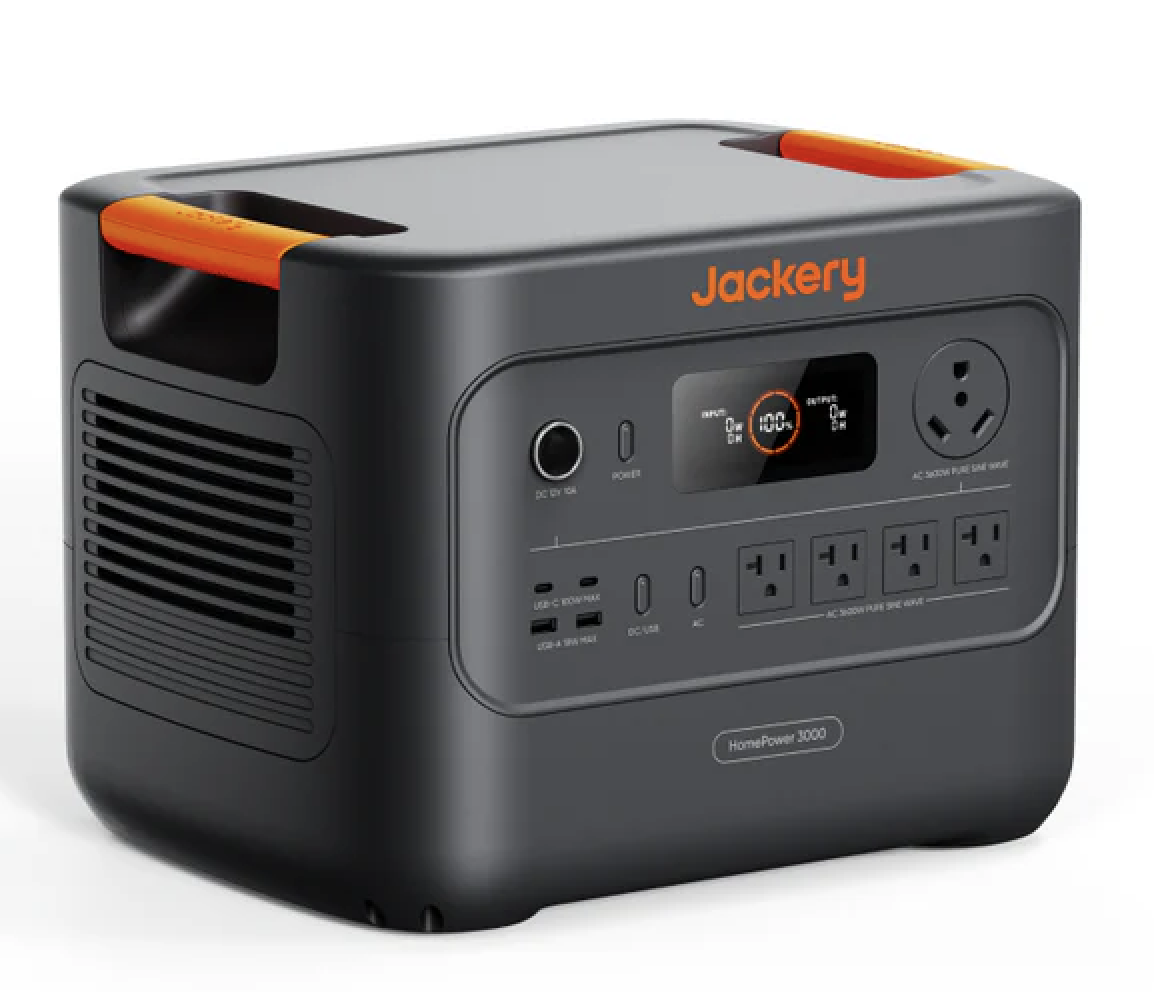

The Jackery HomePower 3000 marks a new direction for Jackery—not just in name, but as part of a wider move toward larger, more home-focused power solutions.
Unlike the popular Jackery Explorer 2000 Plus and Explorer 3000 Pro units, this isn’t a rolling suitcase-style power station. However, it’s heavier, more capable, and, thanks to a few upgrades, arguably a more practical option for long-term use.
But with a new name and a familiar price point, is it just marketing, or is the HomePower 3000 actually worth your money? We put it through our usual real-world testing to find out.
Before we dive into what we like and dislike, let’s quickly go over the specs for this new home power unit:
** Update: You can now purchase the Jackery HomePower 3000 for just $1,699 at Shop Solar!
{{review-summary}}
At first glance, the Jackery HP3000 doesn’t scream innovation. But under the hood, there are some meaningful changes compared to Jackery’s previous flagship unit, the Jackery Explorer 3000 Pro:
A switch from lithium-ion to LiFePO₄ gives this unit a significantly longer lifespan and greater long-term reliability. It’s a nice little upgrade that we feel helps make this power station more competitive.
The Explorer 3000 Pro had a maximum output of 3,000W (hence the name). This HomePower version is now rated to have a 3,600W continuous output via the 30A outlet. This is huge for those looking to power more demanding appliances; however, it makes us wonder why they decided that this would be one of the few units they didn’t make expandable.
Unlike the above-mentioned Explorer 3000 Pro, the Jackery Solar Generator HomePower 3000 delivers full 30A output at 120V. For those with RVs and camper vans, this is a really useful addition.
This is Jackery’s first product in its “HomePower” series, and it seems they designed it more for home backup or off-grid use, rather than portability. Honestly, it seems like a weird decision to not include wheels or at least a better handle, but that’s the direction Jackery decided to go.
With that said, it still passes the Tiny Baby Lift Test. At just under 60 lbs, and thanks to dual handles on either side of the unit, it’s manageable, even without wheels.
After we ran this unit through a bunch of real-world tests over the course of a couple of days, we have to say that there was plenty to like about it. Here’s a quick breakdown of all of the things we liked the most about the Jackery HomePower 3000 Power Station:
As we just mentioned, Jackery fixed a big limitation with the previous 3000 model by finally equipping a unit with a true 30A output. This makes the unit far more useful for RV users or anyone running a dedicated 30A system.
Like with every power station, we wanted to see just how efficient this new unit was. When we tested this out, we discovered that this new Jackery HomePower 3000 delivers something incredibly rare: an idle consumption of just 8 watts. That’s actually the best we’ve seen from any large power station to date!
Keep in mind that the lower the idle consumption, the more stored power actually ends up being usable. Plus, an idle consumption of around just 8 watts means that if you leave the inverter on with a minimal or intermittent load (like a sump pump), you could get over two weeks of standby use. That’s seriously impressive!
Even under a full load, the fans remained quiet, and the unit ran cool. Efficiency and thermal management are both strong suits here. For a unit marketed towards home backup, quiet operation is nothing to sneeze at. It means you can easily run this thing in your living space, without having to worry that it’s going to drive you crazy, or make it difficult to sleep.
It sounds vague, but Jackery stuck with what works. The layout is familiar, the screen is clear, and while it lost its wheels, it’s still light enough to carry thanks to its sturdy handles. It just looks like a Jackery unit, and that’s something a lot of people are going to appreciate, especially given there seems to be some diehard Jackery fans out there.
You can monitor usage, change settings, and turn the inverter on or off remotely using the Jackery app. It’s clean, reliable, and easy to use. We’ve seen plenty of power stations that use generic, low-quality apps, rather than investing the time and money into developing their own proprietary smart apps, so it’s definitely something that's worth pointing out.
Jackery’s website calculator actually accounts for idle consumption, which is incredibly rare in the power station game and solar space.
Instead of being hidden, this information is displayed right on the main product page, making it really easy for buyers to know what to expect if they choose to place an order. By contrast, most companies simply exaggerate what their power stations can do, where Jackery seems committed to providing realistic and transparent performance estimates.
Giving potential buyers an honest idea of real-world runtimes and performance specs is really refreshing. We wish more brands were this honest, so it’s always worth pointing out when a company actually provides legit information.
In a welcome move, Jackery now offers their own SolarSaga 200W bi-facial solar panels. They are pretty expensive, but now you’ll get more solid solar efficiency if you’re someone who wants to stick with a single brand for your entire setup.
With that said, the unit still maxes out at 1,000W of solar input, so charging it via solar is always going to be a little slow, but at least they’ve made strides with their solar panel tech.
As with any of our power station reviews, it wouldn’t be complete unless we pointed out a few things we didn’t like about the HomePower 3000:
At this size and price, a 1,000W solar input is actually pretty underwhelming. Competing units often offer higher solar capacity or multiple inputs, allowing you to charge your power station with solar panels much faster.
If you're relying on solar for multiple days off-grid, this could become a bottleneck, and even a reason to look elsewhere.
We know, we sound repetitive, but this is a big one. Jackery seems to arbitrarily decide which units are expandable, and which ones aren’t. Unfortunately, this one isn’t.
For a large power station that was supposedly designed for at-home backup power, the lack of an expansion port is a major miss. If you need more capacity, your only option is buying an entirely separate unit.
Jackery under-advertises the 3,600W output capability of the 30A port and doesn’t clearly state it on the website product page or anywhere in the packaging and instructions. It’s a weird omission because it’s one of the unit’s best features.
It’s not really a major gripe, but another odd decision from Jackery. If you have something your customers will find appealing, tell them about it.
Robbie says it pretty much every time, and it does genuinely bother us, so just give us a built-in light. Even the smaller Jackery power stations have lights, so the HomePower 3000 should too.
It’s 2025, nobody wants to fumble around with a headlamp during a blackout.
Despite the new “HomePower” branding, there’s not really any wow factor here. It’s a solid upgrade over the Explorer 3000, but there’s no standout feature that makes this feel like the future of Jackery or home backup more generally.
We can’t help but compare this unit to the brand's hugely impressive Jackery 5000 Plus Power Station, which was packed with additional performance features and felt like a true flagship-level release. By contrast, the HomePower 3000 feels a little boring and almost a bit too safe.
Overall, the Jackery HomePower 3000 is a great unit. It performs well, delivers outstanding efficiency, and finally gives users a proper 30A outlet with a real 3,600W inverter. The switch to LiFePO₄ is a big win for the longevity of the unit, and the $2,124 price tag (with code THESOLARLAB) is very fair considering the specs and upgrades.
That said, it’s not a revolutionary product. There’s no expansion, it has a really limited solar input, and there’s just nothing flashy or unique to differentiate it in a crowded market. It’s a great option for a really basic backup power solution, an off-grid cabin, or a weekend camping setup, but it’s not a game-changer.
If you’re comparing it to the Jackery Explorer 3000, this is hands down the better unit. But if you're eyeing some of its similarly sized but expandable competitors, like the Anker SOLIX F2600 or the EcoFlow DELTA 2 Max, you'll want to weigh the trade-offs a bit more carefully.
The Bottom Line: the HomePower 3000 holds up the Jackery name—it’s reliable, efficient, and easy to use. But for their first entry into the “HomePower” series, we were hoping for a little more excitement. We're really excited to see if Jackery steps it up with future releases in this lineup.
